|
|
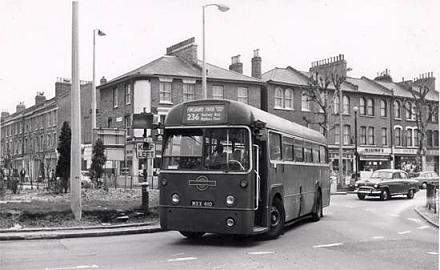 Red RF
routes Red RF
routes
Route 236
Page last updated February 2022
This route has served residential areas between Finsbury Park and Hackney Wick from 1926 to
date, originally as the 263 and running through to Leyton until
1988. The route was the last crew-operated single-deck route
in London, finally converting to one-man operation on 17 April
1971. Leyton Garage operated buses on the route for 60
years.
The first of two views of
the last day of RF operation, 16 April
1971. RF433 from Leyton swings round from Victoria Park Road
into Lauriston Road. Photo © Jim
Blake
Dates of RF operation
26 Nov 58 to 16 Apr 71
(total 12 years 4 months, all crew operation)
Destinations
LEYTON Hainault Road and FINSBURY PARK
Plimsoll Road (daily 26 Nov 58 to 26 Feb 63, Mon-Sat
27 Feb 63 to 6 Sep 68)
LEYTONSTONE L.T. Station and FINSBURY PARK
Plimsoll Road (Mon-Sat 7 Sep 68 to 16 Apr 71)
Peak hour extensions:
LEYTON Hainault Road and STROUD GREEN (Mon-Fri
peaks 26 Nov 58 to 6 Sep 68)
LEYTONSTONE L.T. Station and STROUD GREEN
(Mon-Fri peaks 7 Sep 68 to 16 Apr 71)
Sunday extension:
LEYTONSTONE L.T. Station and GOLDERS GREEN
STATION (Suns 25 Jan 70 to 11 Apr 71)
 RF
Garages RF
Garages
T Leyton
AR Tottenham (to 16 Jan 71)
D Dalston (from 17 Jan 71)
Also on the last day of
crew RFs, RF394 from Dalston is seen outside the
garage operating the rush hour service through to Stroud
Green.
Photo © Roger
Newport
Reason for single-deck operation
Low bridges in Hainault Road and Grove Green Road required
(and still require) single-deck working, and in addition workings
to Stroud Green pass under the low bridge at Finsbury Park.
Route history
The 236 started life in 1926 as independent route 263, running
on weekdays between London Fields Albion Road and
Leyton Essex County Cricket Ground via Hackney Wick,
Leyton Town Hall and Leytonstone. ARO Omnibus
Co started on 1 June with three Dennis single deckers and were
joined on 14 June by Havelock
Motors with another three. Short workings from Leyton
Town Hall to the cricket ground ran as
263 A. On 27 October, the route was extended from
London Fields to Finsbury Park via Ridley Road and Highbury
Grove. In all, six operators worked on the route at various
times.
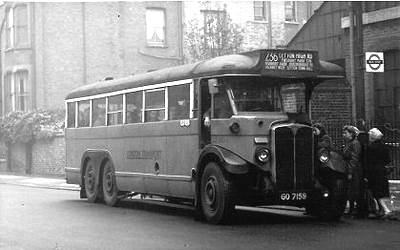 LT Scooters worked the 236 for virtually
the whole of their lives, from new in 1931 until replaced by TDs in
1949. Here is LT1104 loading at the Ridley Street Market stop
in St Marks Rise. Ridley Street Market features in Michael
Parsons' story on the next page. Photo © Alan Cross
The route is an excellent example of the effects of the
restictions introduced in 1925, primarily to reduce the number of
buses running in competition with trams. In addition to the
requirement of the police to approve routes (which led to the
Bassom numbering system), the
Minister could (and did) impose Restricted Streets
Orders. This limited the ability to develop new routes, with
the direct result that the famously tortuous 263 was developed
using back roads along almost its entire length.
The route was obviously busy from the start, as more
competition arrived in December with Fallowfield & Knight
operating two Maudslay ML3 single deckers, followed in May
1927 by HH Clench with three more Dennises. Meanwhile,
Havelock Motors added two and ARO Omnibus another, in December
1926. 1927 brought consolidation, as Fallowfield & Knight
was taken over by Admiral, and then Havelock, ARO Omnibus and
Clench merged into London Public, the grouping of about
half of London's independents led by Admiral's
proprietor. Not to be outdone, Pro Bono Publico added a
Leyland PLSC Lion 32-seater on the route in 1928. Ironically,
the attractiveness of the route let to the route itself being
declared restricted.
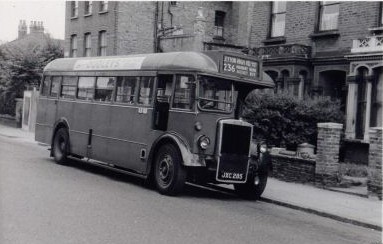 Leyton's TD92 lays over in Plimsoll Road, sometime in
1957-58. The bus is hiding the mobile canteen, see
here. Leyton's TD92 lays over in Plimsoll Road, sometime in
1957-58. The bus is hiding the mobile canteen, see
here.
Photographer unknown
In August 1928, an extension of the route from Leyton to
Chingford was registered, resulting (under the Bassom
scheme) in the 263 being renumbered 263A. The
weekday 263 never operated, although a Sunday 263B to
Chingford Mount ran until September 1930, after which Sunday
operation began on the 263A. The now daily route
was renumbered back to 263 in December 1932.
Meanwhile, after the 1928 Royal Commission on Transport
encouraged the co-ordination of services by the General and London
Public, the General took over operation of the
263A (except for the Pro Bono Publico bus, which
lasted until about mid-1930) in February 1929. Operation was
by Leyton (T) using S type single-deckers and
Tottenham (AR) with Dennis 2½ ton DSs on
loan from Public and still in their blue livery. The latter
were replaced by Ks in 1930 and all by new LT Scooters in summer
1931 (ten to AR and eight to T); two Ts topped up AR's allocation
until October.
With most routes now operated by pneumatics tyred buses, for
which the speed limit was 20mph rather than 12mph, a programme of
speeding up routes using the same frequencies resulted in more
efficient use of buses. This was applied to the 263, where
AR's allocation reduced by three from November 1932.
The route became the 236 with the major renumbering in October 1934, working
daily from Leyton, where the terminus was now known as Leyton
High Road Hainault Road, to Finsbury Park,
where the Plimsoll Road stand was introduced in 1930. The
allocation then comprised 9 LTLs at AR and 8 at T.
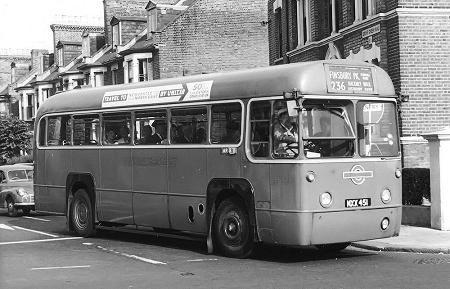 Tottenham-based RF474 pauses at the end of Grove Green
Road, Leyton, on its way to Finsbury Park. The photo is
dated 1955, but the indicator ears suggest it is rather later. Tottenham-based RF474 pauses at the end of Grove Green
Road, Leyton, on its way to Finsbury Park. The photo is
dated 1955, but the indicator ears suggest it is rather later.
Photo Eamonn Kentell
collection
Under London Transport, the route settled to a long stable
existence. The weekday extension to Stroud Green was
introduced in February 1938, but reduced to peak-hour only
operation in three stages in 1941, 1942 and 1944.
Wartime pressures led to the conversion of the Scooters to
perimeter seating for the period 1943-45.
The last 23 Leyland TDs to be delivered replaced the Scooters
from both T and AR during the summer of 1949, some staying on the
route until replaced by RFs on 26 Nov 58. The
RFs were made available by the double-decking of the
Sidcup routes, many of the TDs went to the Kingston area.
Jim Blake's "Odd Men Out" book (Capital Transport) reports
that during the cold winter of 1962/63, Green Line RF107 was
borrowed to help out on the route for a few weeks. Jim has
added that he also saw Green Line RF59 working the 236 in February
1963; the bus was then based at T as a trainer. [Note that if
a bus was taxed as a 'hackney trainer', then it could also be used
in service, whereas a 'private trainer' couldn't - the
latter paid a lower road fund licence but was subject to an
MOT, dipping headlights, etc.] It may be that these vehicles'
use in service was due to red RF overhauls. Has anyone
ever seen a picture of RF59 or RF107 on the route, or
remember their operation? Please let us know.
The RF period saw a number of detailed changes to the route, as
redevelopment and traffic schemes changed the face of Hackney,
Hackney Wick and Leyton. More dramatically, the interchange
with Muswell Hill's route 210
started on 27 Feb 63, when the 236 was withdrawn on Sundays and the
210 extended in its place, running through from Golders Green to
Leyton. Crews and buses from AR and T joined MH in working
the through route. The tables were turned on 25 Jan 70, when
the 210 was converted to OMO RF operation and restricted to its
weekday terminus of Finsbury Park; the through workings were
renumbered 236 to distinguish them as crew buses, over the 210
road, from the OMO 210.
Classic 236. RF379 at the Mare Street lights heads for Leyton
High Road Hainault Road.
Photo © Paul
Redmond
Meanwhile, on 7 Sep 68, the 236 (and the Sunday 210) was cut
back from the Essex County Cricket Ground to Leytonstone Station,
that section being replaced by new OMO route 235, worked by T using
new MBs.
Although passing Dalston garage, the route was operated by
Leyton and Tottenham garages through to January 1971, when
Tottenham's allocation was finally moved to Dalston.
RF operation, and crew operation on single-deck buses in
London, came to an end on Saturday 16 Apr
71, when the route was converted to one-man Swifts. At the
same time, the route was altered in Hackney away from Victoria Park
Road to serve Morning Lane and Wick Road, then the long way round
via Kenworthy Road and Marsh Hill back to Hackney Wick, the latter
section partly replacing the 178 lost
when that route became the S3 on the same day. However,
peak-hour shorts between Dalston Garage and Leytonstone omitted
that diversion. In addition, and presumably due to concern
about the SMS's ability to make the sharp turn at Ridley Road,
westbound journeys were diverted via Wayland Avenue, this diversion
lasting only a year.
SMSs in turn gave way to Leyland Nationals in May 1978 and the
Dalston allocation, which had moved to Ash Grove in 1981, was
withdrawn in 1982 leaving the route to Leyton alone. 1982
also saw a rerouting to serve Newington Green and the withdrawal of
the Stroud Green peak hour extension.
Shades of the 1928 extension appeared in 1987, when the route
was extended north-eastwards, first to Walthamstow then to
Chingford. This lasted only to 1988, when the present day
easterly terminus at Hackney Wick was established. In
May 1989, Leyton garage finally lost the route, initially to
Clapton, after working it for just over 60 years. The route
continues to this day to operate, using single-deckers, from
Finsbury Park to Hackney Wick through the area's back
streets.
As a postscript, modern route 263 from Barnet to Holloway
was extended in 2014 to Highbury Barn, running along a short
section of the 236.
In 1994, Capital Citybus
(then with its Hong Kong owner) operated the route with Volvo B6s
with Alexander Dash bodywork. Here 677 is seen having just
passed Ridley Road Market. Charles Jenkins' site has his
childhood memories of travelling here on TDs. Photo © Charles
Jenkins
RF route in detail, with timing points
To 10 Oct 61: LEYTON Hainault Road, Hainault Road,
Fairlop Road, Leytonstone
Station, Grove Green Road, Union Road (now Langthorne Road),
Warren Road, Leyton Town
Hall, Ruckholt Road, Eastway, Hackney Wick Eastway, Wick Road,
Victoria Park Road, Fremont Street, King Edward Road Mare Street,
Westgate Street, Lansdowne Road, Shrubland Road, Dalston Garage (shown on destination
blinds as London Fields The Havelock), Albion Drive,
Queensbridge Road, Dalston Lane, Ridley Road, St Marks Rise,
Shacklewell Lane, Stoke Newington
Road [junction], Crossway, King Henry's Walk, Mildmay Grove
North, Grosvenor Avenue, Highbury New Park, Highbury Grove,
Highbury Barn Tavern,
Highbury Park, Blackstock Road, Rock Street, Prah Road (return via
St Thomas's Road and Seven Sisters Rd), FINSBURY PARK Plimsoll
Road, extended Mon-Fri peaks: Stroud Green Road, STROUD GREEN
Stapleton (daily)
11 Jun 61 to 28 Feb 67: LEYTON
Hainault Road, Hainault Road, Fairlop Road, Leytonstone Station, (return via Drayton
Road, Fillebrook Road from 1 May 66), Grove Green Road, Union Road
(now Langthorne Road, westbound only diverted via Grove Green Road,
Alexandra Road from 25 Feb 62), Warren Road, Leyton Town Hall, Ruckholt Road,
Eastway, Hackney Wick
Eastway, (westbound, 11 Jun 61 to 27 Nov 63 only,
via Riseholme Street, Cadogan Terrace), Wick Road, Victoria
Park Road, Fremont Street (return via King Edward Road (now
includes Clermont Road, Primrose Square, Moulins Road), Lauriston
Road, Cassland Road to Wick Road), King Edward Road Mare Street,
Westgate Street, Lansdowne Road, Shrubland Road, Dalston Garage (shown on destination
blinds as London Fields The Havelock), Albion Drive,
Queensbridge Road, Dalston Lane, Ridley Road, St Marks Rise,
Shacklewell Lane, Stoke Newington
Road [junction], Crossway, King Henry's Walk, Mildmay Grove
North, Grosvenor Avenue, Highbury New Park, Highbury Grove,
Highbury Barn Tavern,
Highbury Park, Blackstock Road, Rock Street, Prah Road (return via
St Thomas's Road and Seven Sisters Rd), FINSBURY PARK Plimsoll
Road, extended Mon-Fri peaks: Stroud Green Road, STROUD GREEN
Stapleton (daily to 25 Feb 63, then Mon to Sat)
1 Mar 67 to 30 Mar 69: LEYTON Hainault Road (up
to 6 Sep 68), Hainault Road, Fairlop Road, LEYTONSTONE STATION,
(return via Drayton Road, Fillebrook Road), Grove Green Road,
(return via Warren Road, Union Road, now Langthorne Road),
Leyton Town Hall,
Alexandra Road (westbound only), Ruckholt Road, Eastway,
Hackney Wick
Eastway, Wick Road, Victoria Park Road,
Fremont Street (return via King Edward Road (now includes
Clermont Road), Ainsworth Road, Well Street, Cassland Road
to Wick Road), King Edward Road
Mare Street, Westgate Street, Lansdowne Road,
Shrubland Road, Dalston Garage
(shown on destination blinds as London Fields The
Havelock), Albion Drive, Queensbridge Road, Dalston Lane,
Ridley Road, St Marks Rise, Shacklewell Lane, Stoke Newington Road [junction], Crossway,
King Henry's Walk, Mildmay Grove North, Grosvenor Avenue, Highbury
New Park, Highbury Grove, Highbury
Barn Tavern, Highbury Park, Blackstock Road, Rock
Street, Prah Road (return via St Thomas's Road and Seven Sisters
Rd), FINSBURY PARK Plimsoll Road, extended Mon-Fri peaks:
Stroud Green Road, STROUD GREEN
Stapleton (Mon to Sat)
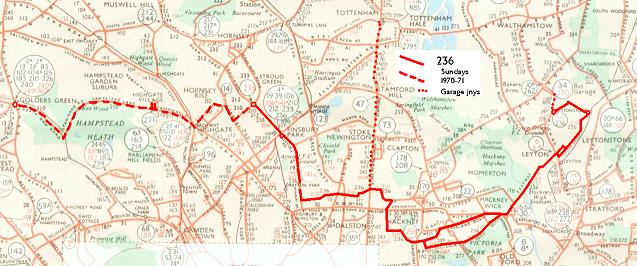 The 1968 route, also showing the Sunday
extension from 1970. Map © London Transport
Mar 69 to 16 Apr 71: LEYTONSTONE STATION, (return via Drayton
Road, Fillebrook Road), Grove Green Road, (return via Warren Road,
Union Road, now Langthorne Road), Leyton Town Hall, Alexandra Road
(westbound only), Ruckholt Road, Eastway, Hackney Wick Eastway, Wick
Road, Victoria Park Road, Fremont Street (return via Mare Street,
Well Street, Cassland Road to Wick Road), King Edward Road Mare Street,
Westgate Street, Lansdowne Road, Shrubland Road, Dalston Garage (shown on destination
blinds as London Fields The Havelock), Albion Drive,
Queensbridge Road, Dalston Lane, Ridley Road, St Marks Rise,
Shacklewell Lane, Stoke Newington
Road [junction], Crossway, King Henry's Walk, Mildmay Grove
North, Grosvenor Avenue, Highbury New Park, Highbury Grove,
Highbury Barn Tavern,
Highbury Park, Blackstock Road, Rock Street, Prah Road (return via
St Thomas's Road and Seven Sisters Rd), FINSBURY PARK Plimsoll
Road, extended Mon-Fri peaks: Stroud Green Road, STROUD GREEN
Stapleton
From 25 Jan 70, reinstated and extended on Sundays:
LEYTONSTONE STATION, Finsbury Park, Hornsey Rise, Archway, Highgate
Hill, Highgate Village, Hampstead Heath, Jack Straws Castle,
GOLDERS GREEN STATION (detail as for 210)
Tottenham garage journeys: from AR via Tottenham High Road,
Stamford Hill, Stoke Newington Road to Crossway (but see Pat
Spencer's notes under Memories). A photo of RF497 in service
passing through Stamford Hill features in John Hambley's 1960 book
(p.101).
Terminal working at Leyton Hainault Road: the
alighting point and time clock were by the railway bridge in
Hainault Road, then Norlington Road, Belgrave Road, King
Edward Road, Hainault Road stand.
Terminal working at Stroud Green:
To 19 Jun 61: Stapleton Hall Road, Mount Pleasant Villas (now
Victoria Road), Mount Pleasant Road (now Crescent) to stand
at Stapleton P.H.
From 20 Jun 61: From stand, via Mount Pleasant Crescent, Mount
Pleasant Villas (now Victoria Road), Stapleton Hall Road.
Frequency
| Year |
Mon-Fri |
Sat |
Sun |
| 1936 |
6 mins |
6 mins |
7½ mins |
| 1938 |
6-8 mins |
6-8 mins |
7½-10 mins |
| 1941 |
7½-10 mins |
7½ mins |
10 |
| 1946 |
6 mins |
6-8 mins |
6-10 mins |
| 1951 |
6-8 mins * |
4-8 mins |
6-10 mins * |
| 1953 |
6-8 mins * |
4-8 mins |
6-10 mins * |
| 1959 |
8-10 mins ‡ |
6-10 mins |
10 mins |
| 1964 |
8-15 mins * |
6-8 mins |
- |
| 1969 |
5-15 mins |
6-8 mins |
- |
| 1971 |
5-15 mins |
6-8 mins |
18 mins
† |
* more frequent Dalston-Leyton
‡ Finsbury Park-Dalston; Dalston-Leyton 5-15 mins
† more frequent Golders Green - Finsbury Park
From Finsbury Park Plimsoll Road, the route took 20 minutes to
Dalston LT Garage, about 40 minutes to Leytonstone Station
and about 46 minutes to Leyton Hainault Road. The
July 1967 timetable is here.
Faretable
In the 1960s, the swapping of Sunday workings between 210 and
236 meant that faretables covered both routes. That for 1965
is here, and that for 1969 (by which time
the eastern terminus was Leytonstone) is here. Both include the
Leyton and Tottenham garage workings.
RF allocation
PVR 1958 (Nov): Mon-Fri 19 (9 AR, 10 T), Sat 17 (9 AR, 8
T), Sun 13 (7 AR, 6 T)
PVR 1962 (Oct): Mon-Fri 19 (9 AR, 10 T), Sat 17 (9 AR, 8
T), Sun 11 (7 AR, 4 T)
PVR 1963 (Feb): Mon-Fri 19 (9 AR, 10 T), Sat 17 (9 AR, 8
T), Sun -
PVR 1968 (Sep): Mon-Fri 18 (8 AR, 10 T), Sat 17 (9 AR, 8
T), Sun -
PVR 1970 (Jan): Mon-Fri 18 (8 AR, 10 T), Sat 16 (8 AR, 8
T), Sun 15 (9 AR, 6 T)
PVR 1971 (Jan): Mon-Fri 18 (8 D, 10 T), Sat 15 (7 D, 8
T), Sun 14 (8 D, 6 T)
Michael Parsons (RIP 4
Feb 2022) emigrated to Canada, but his long career in UK road
transport included a spell driving RFs ‘on the 236 and 210 road out
of Leyton Shed’. He kindly wrote his story (here), which provides a snapshot of life in
north east London after the war.
Pat Spencer was
a Tottenham driver on the 236 from 1965 to 1968, before moving on
to Wood Green. He also recalls the route:
'The RF rota at AR comprised the 236 Monday to Saturday and
210 Sundays. I think there were about 14 duties daily.
On Sundays, some duties were worked by the 171/259 rota, as AR
didn’t run the 171A route on Sundays (Bruce Grove to
Abbey Wood was too long to be worked from Tottenham) [Sunday route
171A Bruce Grove to Abbey Wood ran between 1966 and
1971, operated by NX and WL - Ed]. The rota was called
"The old man’s rota" or "The Scooters" for obvious reasons.
I was the youngest driver on the Scooters in 1965. I
came off the 171 rota as I loved driving RFs and the route was
great to work on. My clippie was Kath Cray (a character if
ever there was one, one of the old school).
New Cross-based RT2912 is seen at Abbey Wood on
the Sunday route 171A. As Pat Spencer recalls
below, AR didn't work the 171 (later the 171A)
on Sunday, so some of the crews from the 171/259 rota worked RFs on
Sundays.
Photo © John King, Ian Armstrong
collection
The garage journeys were (early and late) in
service AR to Crossway, Dalston then left to line of route (never
right turn); Leyton’s T1 went across as AR1 turned left. We used
pick up workers for Lesney’s (Matchbox) of Hackney Wick, mainly at
Stamford Hill. The last bus from Leyton would turn right at
Crossway. During other times we would run out of service to
Finsbury Park (Blackstock Road) via Seven Sisters & Manor
House, returning to Tottenham by the same route.
On Sundays, the 210 was extended to Leyton
High Road in place of the 236 and was operated by MH, T &
AR. It had a 2 to 5 minute service between Golders Green and
Finsbury Park and a 15 to 20 through service. This was mainly
operated by T buses, with MH doing a couple of early and late
journeys (which were not popular with the crews!). AR
also did mainly earlies and lates, with a
couple of journeys during the day. It was a very busy
service (especially on Bank Holidays, when a Sunday service
ran).'
Asked about terminal arrangements, Pat
adds:
'At Leyton Hainault Road, the
alighting point and time clock were by the railway bridge in
Hainault Road. Buses then ran light to the stand -
left into Norlington Road, right Belgrave Road, right King Edward
Road, right to Hainault Road. The stand and pick-up
point was on the left by a cafe (I think it called was called
"Johns" or similar). T crews used it as an impromptu canteen,
and it even had shelves for T conductors to store their Gibson
boxes when on spreadovers (very naughty!). The cafe owner
knew everybody's name and snack/drink preference. As he
also knew who was doing what duty, AR crews' teas were waiting for
them. When it was closed, you could use a chip shop in the
High Road for tea. Toilets in Midland Road station if one was
desperate or otherwise at Hackney Wick and Dalston garage on
route.
Finsbury Park Plimsoll
Road was the alighting point, and
also changeover point for AR crews for through buses to
Stroud Green (peak hours) or Golders Green (Sunday). The
routing to the stand from Rock Street was left into St. Thomas's
Road, left Plimsoll Road, where the LT canteen was on the left [Pat's memory is
playing tricks, as there was a clockwise working round the loop -
which would then have the canteen on the left, as he says -
Ed]. The stand outside was for AR 236s and J 19s whose
crews took their breaks here [buses stood on both sides in practice
- Ed]. Battersea's 19s turned at Highbury Barn. From
the stand, the routing was left into Prah Road [actually St
Thomas's Road, see above], round the station forecourt to Stroud
Green Road. Then through buses turned left, returning buses
turned right to the Blackstock Road pick up stop.
At Stroud Green, terminating buses continued across
the junction where the 210 to Golders Green turned left
into Hanley Rd, into Mount Pleasant Road, where the alighting
point was outside the Stapleton Arms. Leave via
right Victoria Road, right Stapleton Hall Road, left Stroud Green
Road to pick up.
 Under the low bridge at Finsbury Park was
a stop either side of the road marked 210 Suns, 236 M/F Rush
hours only. On occasion an inexperienced double-deck driver
has missed the bus station and seeing the stops ahead has driven on
and created another single-decker.'
One point from Pat's account that is
interesting is the use of the term 'Scooter' for the RF. This
word was originally applied to the single-deck LTs, which ran at AR
from mid-1931 to June 1949. They were succeeded by TDs, which
ran until RFs were introduced in 1958. The term was also
in use at Bromley and Croydon, where RFs directly replaced
LTs, and was obviously fairly widespread. One wonders
whether the TDs also carried the nickname at Tottenham or
elsewhere, presumably they did. Does anyone know more?
Please e-mail.
A Scooter on the 236 just after the war.
Tottenham's LT1145 takes on passengers in Victoria Park Road,
Hackney Wick. In the background is Cadogan Terrace, served by
Qs on the 208. A reminder of how
tired London was after the war; note the chestnut paling, perhaps
replacing metal fencing melted down for the war effort.
Photo Peter Osborn collection
Roy Barnacle, now living
in the US, recalls the buses in the area:
The site brings back many wonderful memories
of my own bus travels In North London. Back then in the
40s-60s, I lived in Wolsey Road just off Newington Green, and was
able to savour the "torturous" 236 along with the famous (or
infamous) Scooters, through the TDs and RFs. Occasionally there was
a Q or two. The 236 route was the route to take if you wanted
to see non-tourist London, from the once fine houses of Highbury,
paralleling the North London line, through the (then) depressed
areas of Dalston and Hackney, and over the "country" of the Lea
Valley, and so forth.
Adventures galore for this small lad.
Besides the 236 (to the Gunners games of course), there was the 581
trolleybus to Epping, the 677 to the docks, trolleybus 647 on the
straightaway to Waltham Cross, tram 33 to the Embankment and the
half day journey on the 16/18 to the hills of Purley. I
particularly loved the central routes that ended in London's
country. 84 to St Albans, 609 to Barnet, and so on. Ongar (with
memories of a pig roast at Toot Hill), and almost any Green LinE
route.
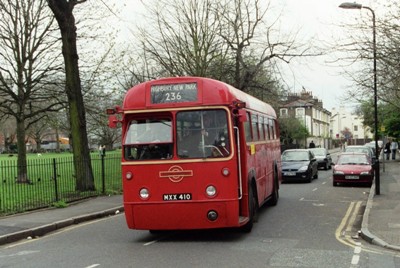 There was a way to get a free ride. The trick
was, if traveling North to ask for a ticket to a destination South.
The conductor would kindly tell me that I was going the wrong way,
and to get off at the next stop, cross the road and get a bus going
the other way. Part of the trick was to go upstairs, to the front
so that time was gained before the conductor reached me, and I had
traveled a good distance in the direction I really wanted to go.
Only once, a conductor saw through me, and made me pay for the
journey I took. There was the time when my dog took a free
ride on 73 heading to Richmond. My dog would meet my mother,
who worked at Kings Cross and took the 73 home. My dog expected her
to be on the first 73 that came along, and not seeing her, boarded
the bus. I ran after the bus shouting that my dog was on
board. The conductor gave a four ring and the bus stopped and let
my dog off. Don't know if it would happen today. There was a way to get a free ride. The trick
was, if traveling North to ask for a ticket to a destination South.
The conductor would kindly tell me that I was going the wrong way,
and to get off at the next stop, cross the road and get a bus going
the other way. Part of the trick was to go upstairs, to the front
so that time was gained before the conductor reached me, and I had
traveled a good distance in the direction I really wanted to go.
Only once, a conductor saw through me, and made me pay for the
journey I took. There was the time when my dog took a free
ride on 73 heading to Richmond. My dog would meet my mother,
who worked at Kings Cross and took the 73 home. My dog expected her
to be on the first 73 that came along, and not seeing her, boarded
the bus. I ran after the bus shouting that my dog was on
board. The conductor gave a four ring and the bus stopped and let
my dog off. Don't know if it would happen today.
I loved London Transport, from LPTB to TfL.
Nothing like it across the pond.
Re-creation
The 236 was operated by RFs for the 35th
anniversary of the end of single-deck crew operation at our 2006
Hackney Marshes Running Day.
Doorless RF433 operated the
236 on the last day, 16 Apr 71, and again on 16 Apr
2006. It is seen here passing London Fields and about to
reach the site of Dalston Garage.
Photo © Geoff Ragg
|
|